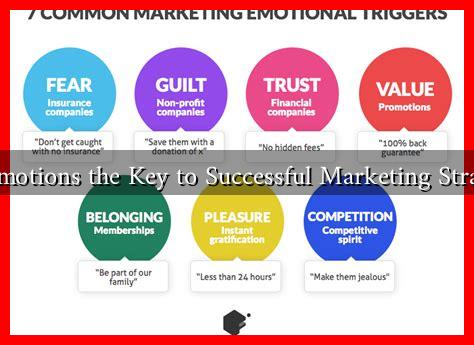-
Table of Contents
- Are Emotions the Key to Successful Marketing Strategies?
- The Emotional Connection in Marketing
- Why Emotions Matter
- Case Studies: Brands That Get It Right
- 1. Nike: Just Do It
- 2. Coca-Cola: Share a Coke
- 3. Dove: Real Beauty
- Statistics That Speak Volumes
- How to Incorporate Emotions into Your Marketing Strategy
- Conclusion
Are Emotions the Key to Successful Marketing Strategies?
In the ever-evolving landscape of marketing, one factor remains constant: the power of emotions. As brands strive to connect with consumers on a deeper level, understanding the emotional triggers that drive purchasing decisions has become paramount. This article explores how emotions play a crucial role in successful marketing strategies, supported by compelling examples, case studies, and statistics.
The Emotional Connection in Marketing
Emotions significantly influence consumer behavior. According to a study by the American Marketing Association, emotional responses to advertisements can lead to a 23% increase in sales. This statistic underscores the importance of crafting marketing messages that resonate emotionally with the target audience.
Why Emotions Matter
Understanding the emotional landscape of consumers can help brands create more effective marketing strategies. Here are some reasons why emotions matter in marketing:
- Brand Loyalty: Emotional connections foster brand loyalty. When consumers feel an emotional bond with a brand, they are more likely to remain loyal, even in the face of competition.
- Decision-Making: Emotions often drive decision-making more than rational thought. Consumers may choose a product based on how it makes them feel rather than its features or price.
- Word of Mouth: Emotionally charged experiences are more likely to be shared. Positive emotional experiences can lead to organic word-of-mouth marketing, amplifying a brand’s reach.
Case Studies: Brands That Get It Right
Several brands have successfully harnessed the power of emotions in their marketing strategies. Here are a few notable examples:
1. Nike: Just Do It
Nike’s “Just Do It” campaign is a prime example of emotional marketing. The brand taps into feelings of empowerment, motivation, and determination. By featuring athletes overcoming challenges, Nike inspires consumers to associate their products with personal achievement and resilience.
2. Coca-Cola: Share a Coke
Coca-Cola’s “Share a Coke” campaign personalized the brand experience by replacing its iconic logo with popular names. This simple yet effective strategy evoked feelings of nostalgia and connection, encouraging consumers to share their experiences on social media. The campaign resulted in a 2% increase in U.S. sales after a decade of decline.
3. Dove: Real Beauty
Dove’s “Real Beauty” campaign challenged traditional beauty standards by featuring real women of all shapes and sizes. This emotionally resonant message not only sparked conversations about self-esteem and body image but also significantly boosted Dove’s sales and brand perception.
Statistics That Speak Volumes
Several studies highlight the impact of emotions on consumer behavior:
- According to a study by Harvard Business Review, emotionally connected customers are more than twice as valuable as highly satisfied customers.
- A report from Forbes found that 70% of purchasing experiences are based on how the customer feels they are being treated.
- Research by Gartner indicates that brands that prioritize emotional engagement see a 23% increase in customer loyalty.
How to Incorporate Emotions into Your Marketing Strategy
To effectively leverage emotions in marketing, consider the following strategies:
- Know Your Audience: Conduct thorough research to understand the emotional triggers of your target demographic.
- Tell a Story: Use storytelling to create relatable narratives that evoke emotions and connect with consumers on a personal level.
- Use Visuals: Incorporate imagery and videos that elicit emotional responses, as visuals can often convey feelings more effectively than words.
- Encourage Engagement: Foster a community around your brand where consumers can share their experiences and emotions related to your products.
Conclusion
In conclusion, emotions are indeed the key to successful marketing strategies. By understanding and leveraging emotional connections, brands can foster loyalty, drive sales, and create memorable experiences for consumers. As demonstrated by successful campaigns from Nike, Coca-Cola, and Dove, tapping into the emotional landscape of consumers can lead to significant business outcomes. As the marketing landscape continues to evolve, brands that prioritize emotional engagement will likely stand out in a crowded marketplace.

